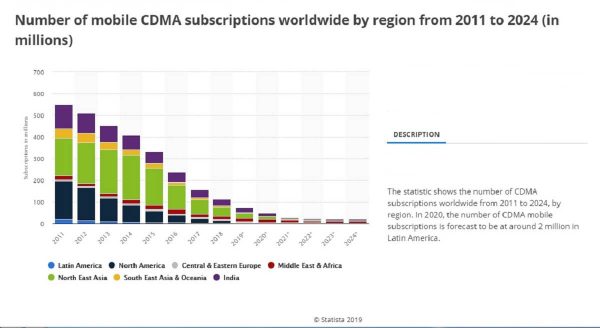Many people are not aware that two different radio systems for mobile phones are working in parallel worldwide. Those are CDMA and GSM networks. Both support transfer of voice and data over a mobile network. You cannot use a CDMA phone on a GSM network and vice versa.
CDMA, by definition, should be able to run on any 4G LTE network just like GSM phones. But the truth is that any phone that needs to support 2G and 3G networks will experience incompatibilities over a 4G network.
As a matter of fact, networks are losing the battle with GSM carriers on a global scale. At the same time, the implementation of new 5G networks will eventually combine the two standards into one common standard.

What Is CDMA?
CDMA stands for Code Division Multiple Access. It is one of the two second-generation systems for cellular phones available today. Even though the shift towards 5G cellular phone networks should, in theory, remove the split between the two types of networks, phones will still behave differently in areas where only 2G or 3G networks are operating.
You can rarely tell a CDMA phone from a GSM one. But, there are fundamental differences. One of them being that CDMA phones do not have a slot for SIM card. Actually, outside of the United States some carriers are supporting phones with SIM slots.
In theory, you can use a phone only with a carrier who permits you to be on their network. Simply put, you can buy an unlocked GSM phone and use it with any carrier. On the other hand, CDMA phones rely on whitelists created by the respective CDMA carrier for network subscription verification. This, in turn, means you can use only CDMA networks that allow your specific phone.
How CDMA Network Works
Qualcom designed and patented the CDMA radio standard for mobile networks. The later WCDMA standard for 3G were developed on the basis of their initial CDMA standard. The fact that CDMA is a patented standard resulted in the limited adoption by carriers.
Actually, both standards are very close in nature with the GSM preceding the former networks.
Carriers use a network is assigning unique codes to calls in order to differentiate between them. The network encodes any call data using a different key, and then the network transmits all calls simultaneously. The receiving tower has the unique key that is used to split the combined signal into individual calls.
Here you can see how a base station is working to transmit the signal:

The technology of the CDMA networks has up to five times greater calling capacity compared to the existing GSM systems. The code division multiple access technology enables multiple transmissions to use the entire system wideband concurrently as opposed to individual time slots or frequency channels that GSM networks use.
Receiving signal on your mobile phone depends solely on the available mobile network infrastructure installed by the local carrier. If you wonder what is CDMA mode and why it is available on some phones, you should know that it is activated to use the phone in areas where networks are available and have better coverage than GSM networks.
Differences between CDMA Phones and GSM Phones
A CDMA phone using the very same technology a GSM phone is using, especially after the introduction of 4G and 5G networks, but usually operates without a SIM card inside.
This is an essential difference, though, as CDMA carriers operate mostly in North America, Russia and some parts of Asia, which in turn means you might be unable to use a CDMA phone outside these areas.

Actually, usage is decreasing worldwide as new mobile network technologies and standards set foot on the market and we are moving toward 5G networks on which any mobile phone, in theory, should work.
Unfortunately, even after the adoption of the latest network technologies a mobile phone might experience troubles making voice calls or sending text messages over Verizon’s network in the United States, as they are using whitelists to verify their subscribers. You will be still able to connect to such a network but the services available to you will be limited.
Final Thoughts
To conclude, CDMA and GSM are two competing standards for mobile networks that share many mobile technologies and which are on course to merge after the adoption of the 5G networks.
On the other hand, you cannot use a GSM card even in a CDMA phone that has a SIM slot, as the networks use a different technology. If you want to use a GSM card on a CDMA network, you need a phone that is able to support also GSM technology. That is why you need to check if your CDMA phones support GSM compatibility if you are frequent traveler.
Actually, a good number of mobile phone manufacturers, including vendors such as Google with their Nexus and Pixel devices as well as Apple, Samsung and Motorola, have phone models that support both networks and can work on any GSM network.
